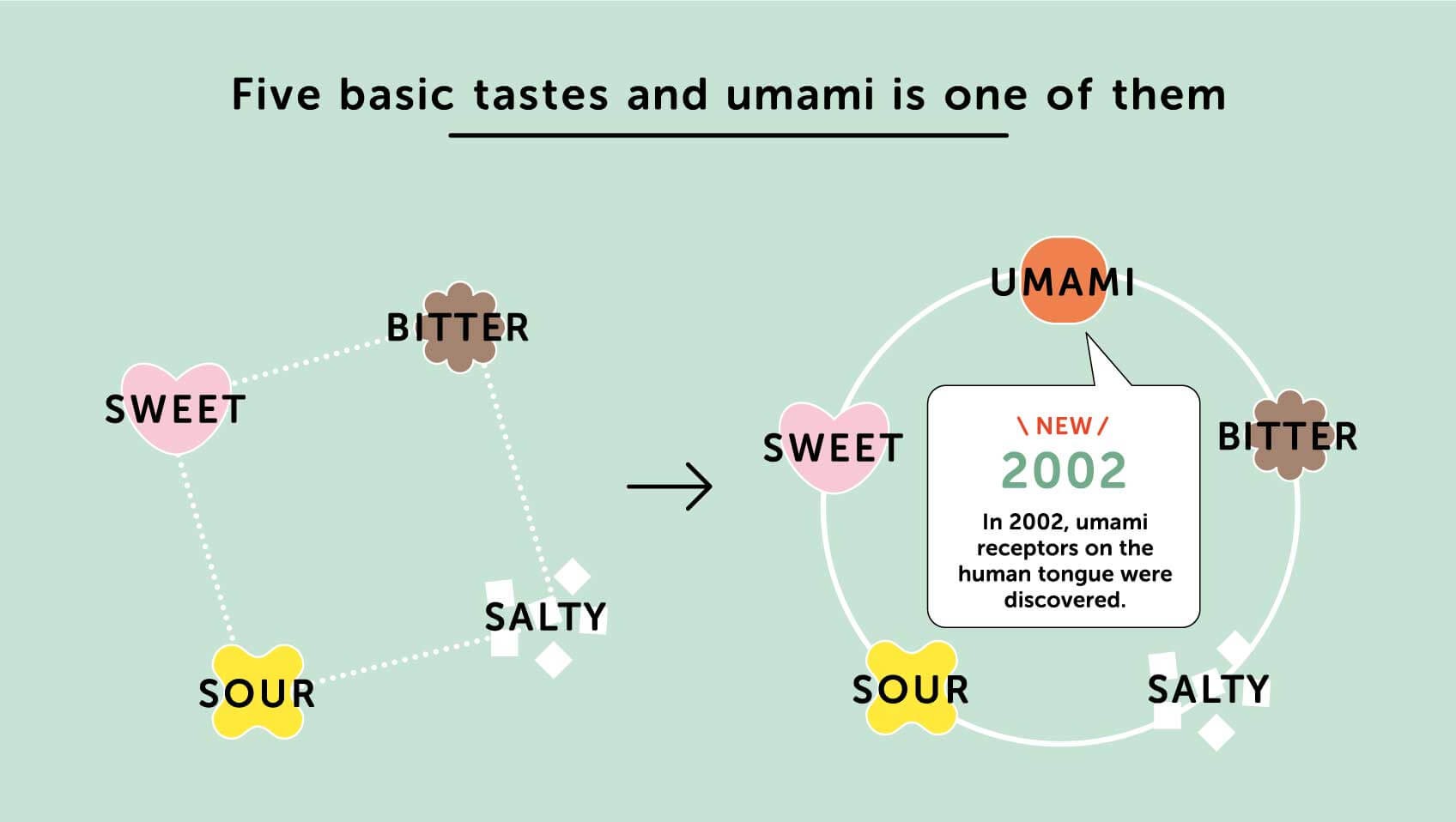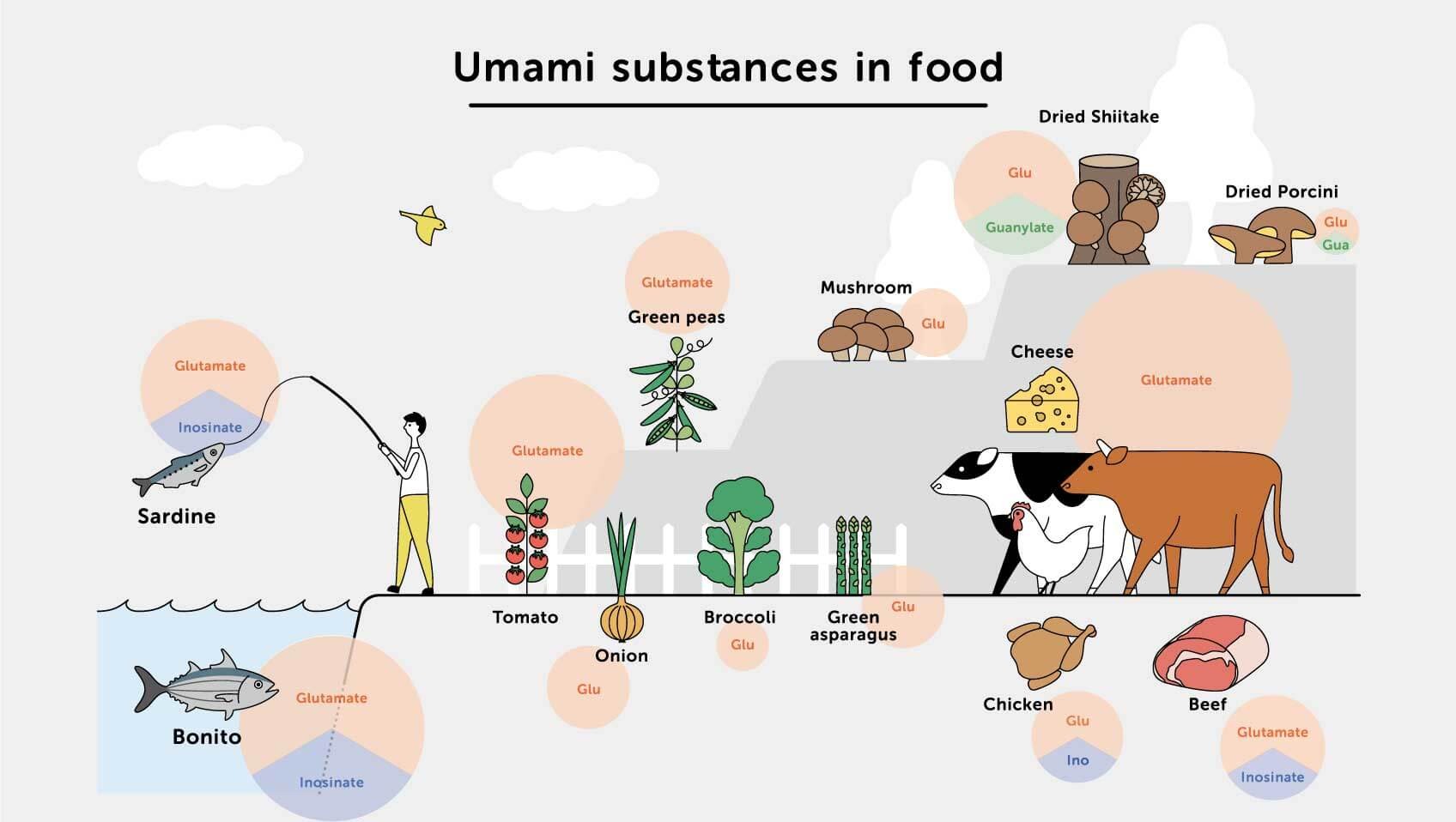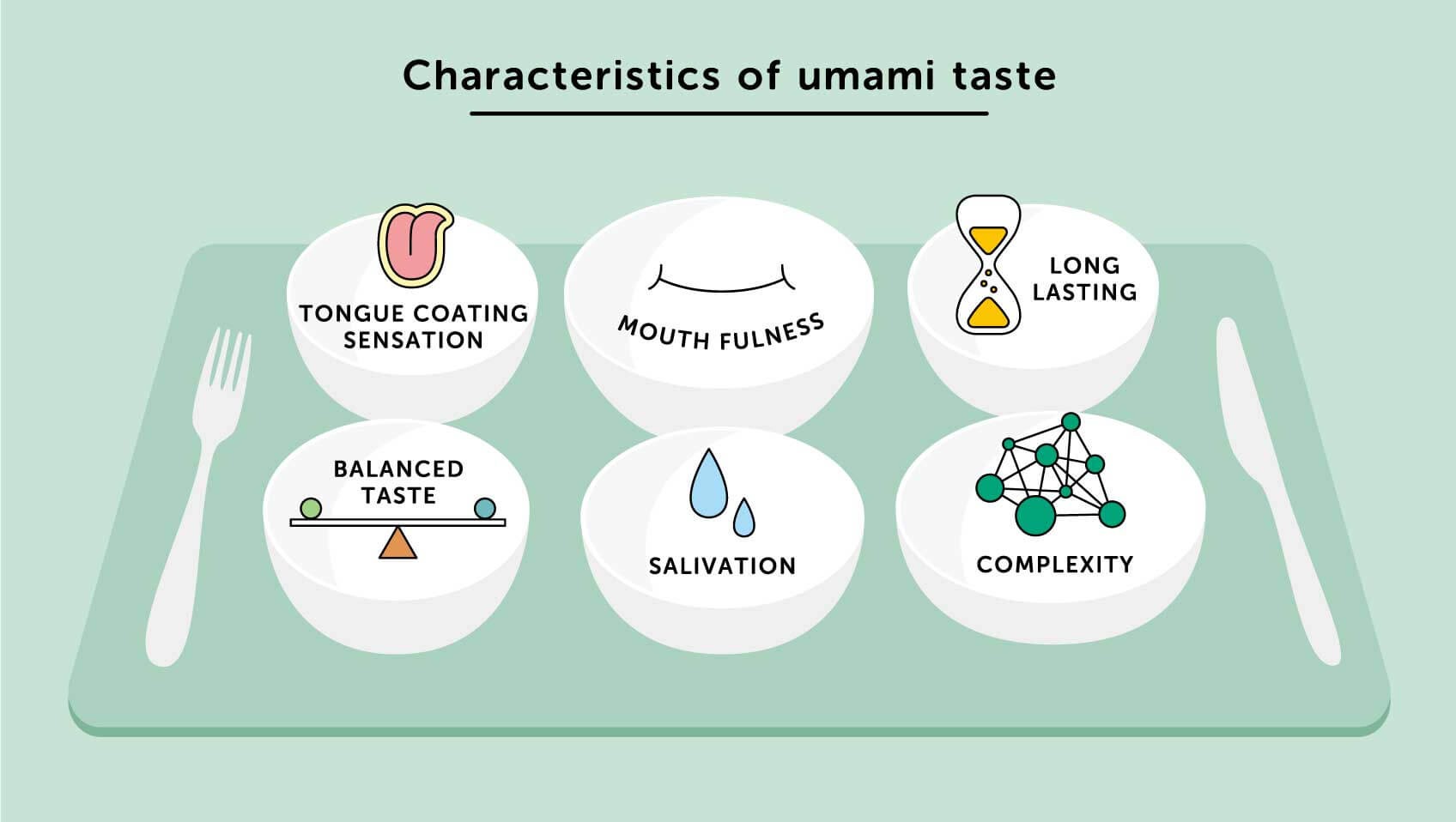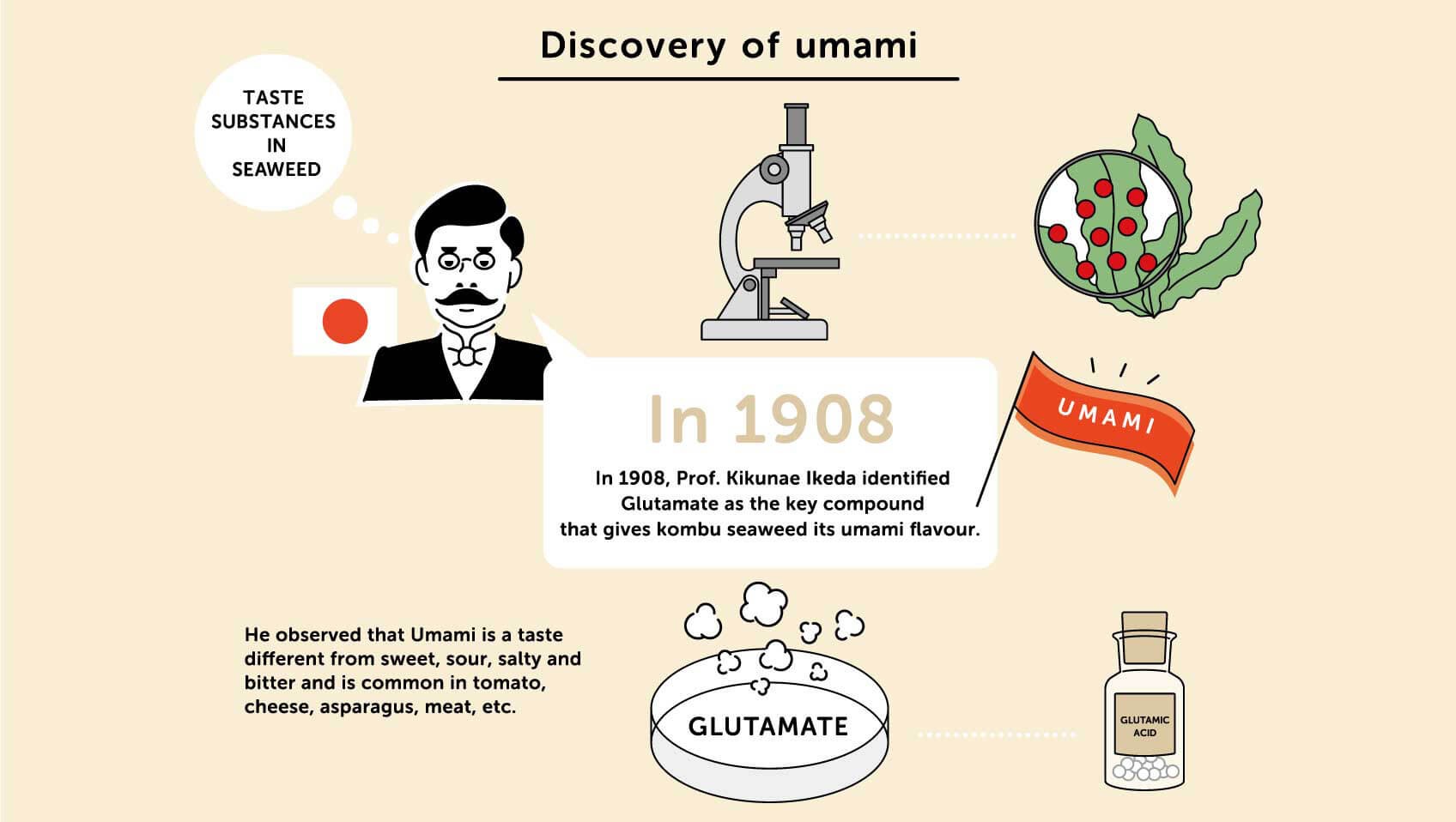What Is Umami Food? Discover the savory delight, rich sources, and health benefits of this fifth taste, enhancing your culinary experience with insights from FOODS.EDU.VN. Unlock the delicious potential of umami and elevate your cooking today.
1. Understanding Umami: More Than Just a Buzzword
Umami, often called the fifth taste, joins sweet, sour, salty, and bitter to complete our flavor palate. Identified in 2002 by scientists who discovered umami taste receptors on the human tongue, umami offers a savory depth that enhances and enriches our food experiences. This inherent taste is universally enjoyed, making umami a crucial element in cuisines worldwide.
2. The Science Behind Umami: Glutamate and Its Role
Technically speaking, umami comes from glutamate, an amino acid that forms the building blocks of protein. Glutamate occurs naturally in the human body and is found in many foods we love. Aging cheeses, cured meats, ripe tomatoes, savory mushrooms, tender salmon, juicy steak, flavorful anchovies, and even green tea are rich in glutamate, providing that distinctive umami flavor.
3. Everyday Foods Rich in Umami: A Culinary Adventure
Umami is present in numerous everyday foods, making it easier than you think to incorporate this savory taste into your meals. Aged cheeses like Parmesan, cured meats such as prosciutto, and vegetables like tomatoes and mushrooms are excellent sources. Seafood, including salmon and anchovies, and even green tea contribute to the umami profile. Adding these ingredients to your cooking will undoubtedly elevate the flavor and depth of your dishes.
Here’s a table showcasing common foods rich in Umami:
| Food Category | Examples | Umami Compound |
|---|---|---|
| Cheeses | Parmesan, Aged Cheddar | Glutamate |
| Meats | Cured Ham, Beef | Glutamate |
| Seafood | Salmon, Tuna, Anchovies | Inosinate |
| Vegetables | Tomatoes, Mushrooms | Glutamate |
| Condiments | Soy Sauce, Miso | Glutamate |




4. Umami and Salt Reduction: A Healthier Approach
Umami not only enriches our diet but also addresses global health issues. Sodium chloride, or table salt, contributes to cardiovascular disease, prompting the World Health Organization to aim for a 30% reduction in average salt intake. Monosodium glutamate (MSG), the key component of umami seasonings like AJI-NO-MOTO®, offers a solution by reducing sodium content without compromising taste. Incorporating umami-rich ingredients and seasonings can enhance flavor while promoting healthier eating habits.
For more on reducing salt without losing flavor, check out these smart solutions.
5. The Distinct Properties of Umami: A Sensory Experience
Umami has three distinct properties that set it apart from other tastes:
- Spreads Across the Tongue: Umami taste evenly coats the tongue, creating a full-bodied flavor experience.
- Long-Lasting: Umami lingers on the palate longer than other basic tastes, providing a satisfying and memorable aftertaste.
- Mouthwatering Sensation: Umami stimulates saliva production, resulting in a mouthwatering sensation that enhances the overall enjoyment of food.
6. Achieving Umami Taste: Tips for the Home Cook
Adding umami to your cooking is simple. Use ingredients rich in glutamate to round out the flavors in any dish. Keep umami boosters like ketchup, miso, truffle oil, ranch dressing, and soy sauce in your pantry. Proteins like pork, beef, fish, and shellfish create strong umami foundations, while vegetables like tomatoes, mushrooms, and seaweeds also offer high glutamate content. For a pure umami boost, add a dash of monosodium glutamate (MSG). Combining these ingredients creates an umami explosion.
Here are some practical tips to infuse your dishes with umami:
- Roast Vegetables: Roasting tomatoes, mushrooms, and bell peppers intensifies their umami flavor.
- Use Broths and Stocks: Bone broths and vegetable stocks are excellent sources of umami.
- Incorporate Fermented Foods: Miso, soy sauce, and fish sauce add depth and umami to sauces and marinades.
- Add Seaweed: Kombu and nori are packed with glutamate and can be used in soups and stocks.
7. The Discovery of Umami: A Japanese Legacy
Umami was discovered over a century ago by Japanese scientist Dr. Kikunae Ikeda. While enjoying a bowl of kelp broth called kombu dashi, he noticed a savory flavor distinct from sweet, sour, bitter, and salty. He named this taste “umami,” meaning “essence of deliciousness” in Japanese, attributing it to glutamate.
8. Umami in Global Cuisines: A Cross-Cultural Delight
Umami is not confined to Japanese cuisine; it’s a universal taste found in various international dishes. For example, Italian cuisine features umami-rich ingredients like tomatoes, Parmesan cheese, and mushrooms. Similarly, Korean cuisine utilizes fermented ingredients such as kimchi and gochujang to deliver umami. Explore how different cultures harness umami to create flavorful and satisfying meals.
Here’s a glimpse of how umami manifests in different cuisines:
| Cuisine | Key Umami Ingredients | Common Dishes |
|---|---|---|
| Japanese | Kombu, Miso, Soy Sauce | Ramen, Miso Soup, Sushi |
| Italian | Tomatoes, Parmesan, Mushrooms | Pasta, Pizza, Risotto |
| Korean | Kimchi, Gochujang | Kimchi Stew, Bibimbap |
| Southeast Asian | Fish Sauce, Shrimp Paste | Pad Thai, Pho, Green Curry |
9. Recipes to Savor Umami: International Inspiration
Nick Lee’s World Umami Cooking Competition-winning recipe combined kombu, Parmigiano Reggiano, tomatoes, and shiitake mushrooms, showcasing the influence of Western and Eastern cultures. Try incorporating these ingredients into your own dishes to experience the harmonious blend of umami flavors.
10. Umami and Aging: Enhancing the Culinary Experience for Seniors
Umami can play a vital role in improving the dining experience for seniors. As taste sensitivity often diminishes with age, umami-rich foods can help stimulate appetite and enhance the enjoyment of meals. Adding umami to senior-friendly recipes ensures they receive the necessary nutrients while savoring every bite.
Explore the benefits of umami for seniors in this insightful article on enjoying longevity.
11. Umami and Plant-Based Diets: A Vegetarian’s Best Friend
Umami is not limited to meat-based dishes; it’s an essential component of many vegetarian and vegan cuisines. Mushrooms, tomatoes, seaweed, and fermented products like miso and soy sauce can provide the umami depth that plant-based dishes need to be satisfying and flavorful. Embrace umami to create delicious and well-rounded vegetarian meals.
Here are some umami-rich plant-based ingredients and how to use them:
| Ingredient | Description | Culinary Uses |
|---|---|---|
| Shiitake Mushrooms | Rich, earthy flavor | Soups, stir-fries, sauces |
| Sun-Dried Tomatoes | Intense, concentrated tomato flavor | Pasta dishes, salads, bruschetta |
| Kombu Seaweed | Umami-packed seaweed used to make dashi broth | Soups, stocks, stews |
| Miso Paste | Fermented soybean paste with a savory-sweet flavor | Marinades, dressings, glazes |
12. Decoding Umami: A Deeper Dive into its Sensory Profile
Understanding the sensory profile of umami can help you better appreciate its role in cooking. Umami is often described as a savory, brothy, or meaty taste that enhances the overall flavor complexity of a dish. Unlike other tastes, umami is not easily recognizable on its own; instead, it blends seamlessly with other flavors, creating a harmonious and satisfying taste experience.
13. Umami and Menu Planning: Crafting Balanced Meals
Incorporating umami into your menu planning is essential for creating balanced and flavorful meals. Consider combining umami-rich ingredients with other taste elements to create a well-rounded culinary experience. For example, pairing sweet roasted vegetables with umami-packed miso glaze or balancing a rich, creamy sauce with a touch of salty Parmesan cheese can elevate your dishes to new heights.
Here’s a simple guide to incorporating umami into your menu:
| Meal | Umami Ingredient | Complementary Flavors | Dish Ideas |
|---|---|---|---|
| Breakfast | Sun-Dried Tomatoes | Fresh Herbs, Feta Cheese | Sun-Dried Tomato and Feta Omelet |
| Lunch | Miso Paste | Ginger, Garlic, Green Onions | Miso Noodle Soup |
| Dinner | Shiitake Mushrooms | Thyme, Garlic, Red Wine | Mushroom Risotto |
14. The Future of Umami: Innovations and Trends
The culinary world continues to explore the possibilities of umami, with chefs and food scientists discovering new ways to harness its flavor-enhancing properties. From innovative fermentation techniques to novel ingredient combinations, the future of umami is bright. Stay tuned to FOODS.EDU.VN for the latest trends and developments in the world of umami.
15. Umami and Culinary Arts: Mastering the Fifth Taste
For culinary enthusiasts and professional chefs, mastering umami is essential for creating exceptional dishes. Understanding how to balance umami with other flavors and textures can elevate your cooking to a new level. Experiment with umami-rich ingredients and techniques to develop your own signature style and delight your diners.
Here are some advanced techniques to explore:
- Umami Layering: Combining multiple umami-rich ingredients in a single dish to create a complex flavor profile.
- Fermentation: Experimenting with homemade fermented products like miso and kimchi to add unique umami notes.
- Sous Vide: Using sous vide cooking to enhance the umami flavor of meats and vegetables.
16. Umami in Sauces and Marinades: Enhancing Flavor Profiles
Umami-rich sauces and marinades can transform ordinary dishes into culinary masterpieces. Soy sauce, miso, fish sauce, and Worcestershire sauce are excellent sources of umami that can be used to add depth and complexity to a variety of recipes. Experiment with different combinations of these ingredients to create your own signature sauces and marinades.
Here are some sauce and marinade ideas using umami-rich ingredients:
| Sauce/Marinade | Key Ingredients | Uses |
|---|---|---|
| Miso Glaze | Miso Paste, Mirin, Soy Sauce | Glazing grilled vegetables or fish |
| Soy-Ginger Marinade | Soy Sauce, Ginger, Garlic, Sesame Oil | Marinating chicken, beef, or tofu |
| Fish Sauce Vinaigrette | Fish Sauce, Lime Juice, Chili | Dressing salads or grilled seafood |
17. Umami and Snacking: Elevating Your Snack Game
Umami is not just for main meals; it can also enhance your snacking experience. Consider incorporating umami-rich ingredients into your snacks to create satisfying and flavorful bites. Roasted seaweed snacks, Parmesan crisps, and edamame seasoned with soy sauce are just a few examples of umami-packed snacks that can satisfy your cravings.
Here are some easy umami snack ideas:
- Roasted Seaweed Snacks: Crispy and umami-rich.
- Parmesan Crisps: Savory and cheesy.
- Edamame with Soy Sauce: Simple and satisfying.
- Mushroom Jerky: A vegan alternative to traditional jerky.
18. Umami and Comfort Food: A Soul-Satisfying Combination
Umami plays a key role in the appeal of many comfort foods. The rich, savory flavors of dishes like macaroni and cheese, lasagna, and shepherd’s pie are often attributed to their high umami content. Incorporating umami-rich ingredients into your favorite comfort food recipes can enhance their flavor and make them even more satisfying.
Here are some umami-rich comfort food ideas:
- Mac and Cheese: Use aged cheddar and Parmesan cheese for extra umami.
- Lasagna: Layer with Bolognese sauce, ricotta cheese, and mozzarella.
- Shepherd’s Pie: Top with mashed potatoes and a rich, savory gravy.
- Ramen: A classic comfort food with a complex umami broth.
19. Umami and Fermentation: Unlocking New Flavors
Fermentation is a powerful tool for unlocking new umami flavors. Fermented foods like kimchi, miso, and soy sauce are rich in glutamate and other compounds that contribute to their savory taste. Experimenting with fermentation techniques can add depth and complexity to your cooking.
Here are some fermentation projects to try:
- Homemade Kimchi: A spicy and tangy Korean staple.
- Miso Paste: A versatile ingredient for soups, marinades, and glazes.
- Soy Sauce: A classic condiment with a rich, umami flavor.
- Kombucha: A fermented tea with a tangy and slightly sweet flavor.
20. Umami in Beverages: Beyond Food
Umami is not limited to food; it can also enhance the flavor of certain beverages. Green tea, tomato juice, and even some wines contain umami compounds that contribute to their overall taste profile. Exploring umami in beverages can provide a new perspective on flavor and enhance your drinking experience.
Here are some umami-rich beverages to try:
- Green Tea: Especially matcha and sencha varieties.
- Tomato Juice: A savory and refreshing drink.
- Red Wine: Certain varieties, such as Cabernet Sauvignon and Merlot.
- Dashi Broth: A Japanese soup stock with a rich umami flavor.
21. The Art of Balancing Umami: Culinary Harmony
Balancing umami with other flavors is essential for creating harmonious and satisfying dishes. Too much umami can be overpowering, while too little can leave a dish feeling flat. The key is to find the right balance that complements the other flavors and creates a well-rounded taste experience.
Here are some tips for balancing umami in your cooking:
- Use Acid: Add a touch of acidity (such as lemon juice or vinegar) to balance the richness of umami.
- Incorporate Sweetness: A hint of sweetness can complement the savory flavor of umami.
- Add Bitterness: A touch of bitterness can add complexity and depth to umami-rich dishes.
- Consider Texture: Pair umami-rich ingredients with contrasting textures for a more interesting mouthfeel.
22. Umami and the Five Basic Tastes: A Complete Palette
Understanding how umami interacts with the other four basic tastes (sweet, sour, salty, and bitter) is essential for creating well-balanced and flavorful dishes. Umami can enhance the sweetness of certain ingredients, balance the acidity of others, complement salty flavors, and add depth to bitter notes. By mastering the art of combining these five tastes, you can create culinary masterpieces that delight the senses.
Here’s a breakdown of how umami interacts with the other basic tastes:
| Taste | How Umami Enhances It | Example Dish |
|---|---|---|
| Sweet | Adds depth and complexity | Caramelized Onions with Balsamic Glaze |
| Sour | Balances acidity and adds richness | Tomato Soup with a Dollop of Crème Fraîche |
| Salty | Complements and enhances saltiness | Parmesan Crisps with Sea Salt |
| Bitter | Adds depth and reduces harshness | Dark Chocolate with Sea Salt and Miso Caramel |
23. Umami and Molecular Gastronomy: Pushing Culinary Boundaries
Molecular gastronomy explores the scientific principles behind cooking, and umami plays a significant role in this field. Chefs use techniques like spherification, foams, and gels to create innovative dishes that showcase the unique properties of umami. By understanding the molecular structure of umami compounds, chefs can push the boundaries of culinary creativity.
Here are some molecular gastronomy techniques that can enhance umami flavors:
- Spherification: Creating small spheres of umami-rich liquids that burst in your mouth.
- Foams: Light and airy foams infused with umami flavors.
- Gels: Transforming umami-rich sauces into solid gels for a unique texture.
24. Umami and Food Pairings: Creating Culinary Symphonies
Experimenting with food pairings is a fun and creative way to explore the possibilities of umami. Certain ingredients naturally complement each other, creating harmonious flavor combinations that delight the senses. By understanding these pairings, you can create culinary symphonies that showcase the best of umami.
Here are some classic umami food pairings to try:
- Tomatoes and Basil: A classic Italian combination with sweet, savory, and herbaceous notes.
- Mushrooms and Garlic: An earthy and aromatic pairing that’s perfect for soups and sauces.
- Parmesan and Truffle Oil: A luxurious combination with rich, savory, and earthy flavors.
- Soy Sauce and Ginger: An Asian-inspired pairing that’s perfect for marinades and stir-fries.
25. Umami Around the World: A Global Culinary Journey
Embark on a culinary journey around the world to discover the diverse ways that umami is used in different cuisines. From the savory broths of Japan to the rich stews of Europe, umami is a universal flavor that transcends cultural boundaries. By exploring these diverse culinary traditions, you can gain a deeper appreciation for the power of umami.
Here are some examples of umami-rich dishes from around the world:
- Japan: Ramen, Miso Soup, Sushi
- Italy: Pasta Bolognese, Pizza, Risotto
- Korea: Kimchi Stew, Bibimbap
- France: Beef Bourguignon, Onion Soup
- Mexico: Mole Poblano, Enchiladas
26. The Role of Umami in Reducing Food Waste: Sustainable Cooking
Umami can play a role in reducing food waste by enhancing the flavor of otherwise bland or discarded ingredients. Vegetable scraps, bones, and stale bread can be transformed into flavorful broths and stocks with the help of umami-rich ingredients. By using these techniques, you can create delicious meals while minimizing waste and promoting sustainable cooking practices.
Here are some ways to use umami to reduce food waste:
- Vegetable Broth: Use vegetable scraps to make a flavorful broth with kombu and shiitake mushrooms.
- Bone Broth: Simmer bones with vegetables and herbs to create a nutrient-rich bone broth.
- Breadcrumbs: Toast stale bread and grind it into breadcrumbs seasoned with Parmesan cheese and herbs.
27. Umami and the Senses: A Holistic Culinary Experience
Umami is not just about taste; it’s about creating a holistic culinary experience that engages all the senses. The aroma, texture, and presentation of a dish can all contribute to the overall enjoyment of umami. By paying attention to these sensory details, you can create meals that are not only delicious but also visually appealing and satisfying.
Here are some tips for creating a holistic umami experience:
- Aroma: Use aromatic herbs and spices to enhance the savory fragrance of umami-rich dishes.
- Texture: Pair umami ingredients with contrasting textures for a more interesting mouthfeel.
- Presentation: Arrange your dishes in an appealing way to enhance the visual enjoyment of umami.
28. The Psychology of Umami: Why We Crave Savory Flavors
Understanding the psychology of umami can help you better appreciate its role in our diets. Umami is associated with feelings of satisfaction, comfort, and nourishment. This may be due to its presence in protein-rich foods, which are essential for our survival. By understanding these psychological connections, you can create meals that not only taste good but also make you feel good.
Here are some psychological factors that contribute to our craving for umami:
- Association with Protein: Umami is often associated with protein-rich foods, which are essential for our health.
- Comfort and Satisfaction: Umami can trigger feelings of comfort and satisfaction, making us crave savory flavors.
- Emotional Connection: Certain umami-rich dishes may evoke memories and emotions, enhancing our enjoyment of them.
29. Umami and Childhood Memories: A Taste of Nostalgia
For many people, umami is associated with childhood memories and comforting family meals. The savory flavors of dishes like grandma’s soup or mom’s meatloaf can evoke feelings of nostalgia and warmth. By recreating these dishes, you can tap into these emotional connections and create meals that are not only delicious but also meaningful.
Here are some childhood memories that may be associated with umami:
- Grandma’s Soup: A comforting and nourishing soup made with vegetables, herbs, and meat broth.
- Mom’s Meatloaf: A classic American dish with a savory and satisfying flavor.
- Family Holiday Meals: Special dishes that are prepared for holidays and family gatherings.
30. Umami and the Future of Food: Sustainable and Flavorful Solutions
As we look to the future of food, umami can play a role in creating sustainable and flavorful solutions. Plant-based diets, fermented foods, and innovative cooking techniques can all help us harness the power of umami to create meals that are both delicious and environmentally friendly. By embracing these sustainable practices, we can ensure that future generations can enjoy the benefits of umami for years to come.
Here are some ways that umami can contribute to a more sustainable food system:
- Plant-Based Diets: Umami-rich ingredients can enhance the flavor of plant-based dishes, making them more appealing.
- Fermented Foods: Fermentation can unlock new umami flavors and reduce food waste.
- Innovative Cooking Techniques: Techniques like sous vide and fermentation can enhance the flavor of sustainable ingredients.
Frequently Asked Questions About Umami Food
Q1: What exactly does umami taste like?
Umami is best described as a savory, meaty, or brothy flavor that enhances and deepens the taste of food. It’s not sweet, sour, salty, or bitter but adds a rich, mouthwatering quality to dishes.
Q2: How is umami different from the other basic tastes?
Unlike sweet, sour, salty, and bitter, umami provides a savory depth that lingers on the palate. It’s often described as a background flavor that enhances the overall taste complexity of a dish.
Q3: Can you name some common umami-rich foods?
Common foods high in umami include aged cheeses like Parmesan, cured meats like prosciutto, ripe tomatoes, mushrooms, seaweed (especially kombu), soy sauce, and fish sauce.
Q4: Is umami only found in Asian cuisine?
No, umami is not limited to Asian cuisine. While it was discovered in Japan, umami is present in many international dishes, including Italian pasta sauces, French stews, and Mexican moles.
Q5: Is MSG (monosodium glutamate) the same as umami?
MSG is the purest form of umami. It’s a sodium salt of the amino acid glutamate and is used as a flavor enhancer to add umami to dishes.
Q6: Is MSG safe to consume?
Yes, MSG is generally recognized as safe (GRAS) by the U.S. Food and Drug Administration (FDA) and the World Health Organization (WHO). Some people may be sensitive to MSG, but it is safe for most people in moderate amounts.
Q7: How can I add more umami to my cooking?
You can add umami to your cooking by incorporating umami-rich ingredients, using broths and stocks, adding fermented foods, and experimenting with sauces and marinades.
Q8: Can vegetarians and vegans enjoy umami?
Yes, vegetarians and vegans can enjoy umami. Plant-based sources of umami include mushrooms, tomatoes, seaweed, miso, soy sauce, and nutritional yeast.
Q9: How does umami affect the aging process and diet for seniors?
Umami can enhance the flavor of foods for seniors, who may experience a decline in taste sensitivity. It stimulates appetite and ensures seniors enjoy their meals, contributing to better nutrition.
Q10: Where can I learn more about umami and culinary techniques?
You can discover more about umami and various culinary techniques on FOODS.EDU.VN, which offers a wealth of resources for food enthusiasts and professionals alike.
Unlock the world of umami and elevate your culinary skills with FOODS.EDU.VN. Explore our comprehensive guides, recipes, and expert tips to create unforgettable dishes that delight your senses.
Ready to transform your cooking? Visit FOODS.EDU.VN today and discover the endless possibilities of umami Address: 1946 Campus Dr, Hyde Park, NY 12538, United States. Whatsapp: +1 845-452-9600. Website: foods.edu.vn.
